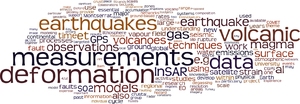NCEO:Theme 6: Difference between revisions
No edit summary |
No edit summary |
||
| Line 27: | Line 27: | ||
Volcanic SO<sub>2</sub> is a key gas species for the planet’s radiative balance and atmospheric composition (Graf | Volcanic SO<sub>2</sub> is a key gas species for the planet’s radiative balance and atmospheric composition (Graf | ||
et al., 1997; Robock, 2000; Grainger and Highwood, 2003; Millard et al., 2006), and, in combination | et al., 1997; Robock, 2000; Grainger and Highwood, 2003; Millard et al., 2006), and, in combination | ||
with other species, for understanding magmatic processes. Volcanic | with other species, for understanding magmatic processes. Volcanic SO<sub>2</sub> is also a significant component | ||
of the stratospheric | of the stratospheric sulphur budget (Pyle et al., 1996), however volcanic SO<sub>2</sub> release to the atmosphere is both | ||
uncertain and variable (7–11 Tg S yr-1, Mather et al., 2003) and individual volcanic emissions can cause | uncertain and variable (7–11 Tg S yr-1, Mather et al., 2003) and individual volcanic emissions can cause | ||
large local and regional perturbations. Recent developments in satellite-borne remote sensing of | large local and regional perturbations. Recent developments in satellite-borne remote sensing of | ||
| Line 42: | Line 42: | ||
Volcanoes generate readily measurable ground deformation in response to influx and efflux of magma | Volcanoes generate readily measurable ground deformation in response to influx and efflux of magma | ||
and gases. One strand of this sub-theme | and gases. One strand of this sub-theme is to relate detailed quantitative budgets of the fluxes | ||
of erupted gas, lava, and tephra to the ground deformation at selected volcanoes in order to constrain | of erupted gas, lava, and tephra to the ground deformation at selected volcanoes in order to constrain | ||
physical models of the volcanic processes. It has recently been shown, however, that external forcings | physical models of the volcanic processes. It has recently been shown, however, that external forcings | ||
| Line 53: | Line 53: | ||
delivery of magma to the earth’s surface (most of which takes place at the oceanic ridges), and we shall | delivery of magma to the earth’s surface (most of which takes place at the oceanic ridges), and we shall | ||
undertake regional scale deformation studies of selected rift systems in order to constrain the kinematics | undertake regional scale deformation studies of selected rift systems in order to constrain the kinematics | ||
and dynamics of such zones | and dynamics of such zones. | ||
==Publications== | ==Publications== | ||
Revision as of 23:28, 15 December 2012
National Centre for Earth Observation: Theme 6
NCEO: Theme 6 is a component of the National Centre for Earth Observation funded by NERC.
EODG's contribution to this theme is to use EO data to measure global and regional budgets of volcanic emissions, particularly of SO2. Working with our collaborators we will integrate these measurements with regional- to local-scale measurements of volcanic emissions, ground deformation, and seismicity, to improve mathematical models for the mechanics of volcanic systems.
Volcanic SO2 is a key gas species for the planet’s radiative balance and atmospheric composition (Graf et al., 1997; Robock, 2000; Grainger and Highwood, 2003; Millard et al., 2006), and, in combination with other species, for understanding magmatic processes. Volcanic SO2 is also a significant component of the stratospheric sulphur budget (Pyle et al., 1996), however volcanic SO2 release to the atmosphere is both uncertain and variable (7–11 Tg S yr-1, Mather et al., 2003) and individual volcanic emissions can cause large local and regional perturbations. Recent developments in satellite-borne remote sensing of volcanic gases and particles allow us, for the first time, to detect and measure volcanic emissions on a global scale in near-real time. These advances will enable us to investigate the controls on these fluxes, and to understand their consequences for the Earth’s surface and atmosphere.
The processes of magma ascent and eruption depend strongly upon the evolution of the magma’s physical properties as it partitions into melt, crystals and gas during ascent, upon the mechanical interactions between magma and its surrounding rock, which determine the magma’s pathways through the crust, and upon the local stress regime. We plan observations on a hierarchy of scales from the global to the regional down to the individual volcano, to address different aspects of volcanic systems.
Volcanoes generate readily measurable ground deformation in response to influx and efflux of magma and gases. One strand of this sub-theme is to relate detailed quantitative budgets of the fluxes of erupted gas, lava, and tephra to the ground deformation at selected volcanoes in order to constrain physical models of the volcanic processes. It has recently been shown, however, that external forcings (the hydrological cycle; large earthquakes) influence volcanic activity on a range of spatial and temporal scales (Neuberg, 2000; Mason et al., 2004; Manga and Brodsky, 2006), suggesting that magmatic systems may be sensitive to small stress changes organized on a scale much larger than that of an individual volcano. For this reason, we shall combine measurements of gas emissions and ground deformation on the largest scales that are practicable, to test hypotheses about external forcings of volcanic arcs. Rift zones are the only examples accessible to direct observation of the major means of delivery of magma to the earth’s surface (most of which takes place at the oceanic ridges), and we shall undertake regional scale deformation studies of selected rift systems in order to constrain the kinematics and dynamics of such zones.
